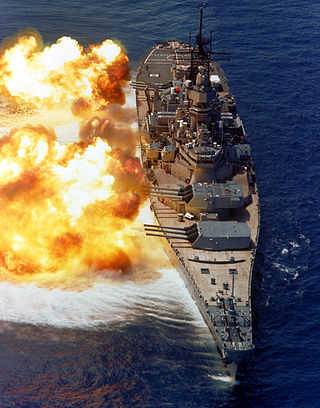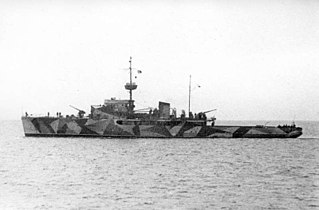
A battleship is a large armored warship with a main battery consisting of large caliber guns. It dominated naval warfare in the late 19th and early 20th centuries.
Antony Martin Douglas Leslie William Calhoun Preston was an English naval historian and editor, specialising in the area of 19th and 20th-century naval history and warship design.

HMS Woolston was a W-class destroyer of the Royal Navy. She served through two world wars, surviving both of them.

HMS Wolfhound was one of 21 W-class destroyers built for the Royal Navy during the First World War. Completed in 1918 the ship only played a minor role in the war before its end. The ship was converted into an anti-aircraft escort destroyer during the Second World War and was badly damaged during the Dunkirk evacuation. Wolfhound survived the war and was sold for scrap in 1948.
Conway Publishing, formerly Conway Maritime Press, is an imprint of Bloomsbury Publishing. It is best known for its publications dealing with nautical subjects.

NMS Amiral Murgescu was a minelayer and convoy escort of the Romanian Navy, the first sea-going warship built in Romania and the largest Romanian-built warship of World War II. She laid numerous minefields, from the Bulgarian port of Burgas to the Crimean port of Sevastopol, which inflicted significant losses to the Soviet Black Sea Fleet. She also carried out numerous convoy escort missions and took part in the Axis evacuation of the Crimea in May 1944. Due to her success in combat, she was decorated twice by May 1944. She was captured by the Soviet Union in September 1944 and served until 1988, when she was scrapped.
The Romanian Navy during World War II was the main Axis naval force in the Black Sea campaigns and fought against the Soviet Union's Black Sea Fleet from 1941 to 1944. Operations consisted mainly of mine warfare, but there were also escort missions and localized naval engagements. The largest naval action fought by the Romanian Navy was the 26 June 1941 Raid on Constanța, and its most extensive operation was the 1944 evacuation of the Crimea.
HMS TB 12 was a Cricket-class coastal destroyer or torpedo-boat of the British Royal Navy. TB 12 was built by the shipbuilder Yarrow from 1905 to 1907. She was used for local patrol duties in the First World War and was sunk by a German mine in the North Sea on 10 June 1915.
HMS TB 11 was a Cricket-class coastal destroyer or torpedo-boat of the British Royal Navy. TB 11 was built by the shipbuilder Yarrow from 1905 to 1907. She was used for local patrol duties in the First World War and was sunk by a German mine in the North Sea on 7 March 1916.
HMS TB 9 was a Cricket-class coastal destroyer or torpedo-boat of the British Royal Navy. TB 9 was built by the shipbuilder Thornycroft from 1905 to 1907. She was used for local patrol duties in the First World War and was sunk following a collision in the North Sea on 26 July 1916.
HMS TB 13 was a Cricket-class coastal destroyer or torpedo-boat of the British Royal Navy. TB 13 was built by the shipbuilder J S White from 1907 to 1908. She was used for local patrol duties in the First World War and was sunk following a collision on 26 January 1916.

HMS Opossum was a "twenty-seven knotter" torpedo boat destroyer of the British Royal Navy. Built by the Tyneside shipbuilder Hawthorn Leslie, Opossum was one of three destroyers built by Hawthorns that were ordered in 1894. She was launched in 1895 and completed in 1896. She remained in service during the First World War, where she was used for local patrol duties based at Plymouth and sank the German submarine UC-49 on 8 August 1918. She was sold for scrap in 1920.

HMS Moresby was a Admiralty M-class destroyer which served with the Royal Navy during the First World War. The M class were an improvement on the previous L-class, capable of higher speed. Originally laid down as HMS Marlion by J. Samuel White at East Cowes on the Isle of Wight, the vessel was renamed before being launched on 20 November 1915. At the Battle of Jutland, the destroyer was initially cover for the seaplane tender Engadine but soon joined the action as part of a flotilla led by the light cruiser Champion. Moresby attacked the German fleet with torpedoes, initially unsuccessfully targeting the dreadnought battleship Markgraf and, near the end of the battle, unleashing another which narrowly missed the battlecruiser Von der Tann. In March 1918, the destroyer sank U-110 with the destroyer Michael. After the war, the destroyer was placed in reserve and eventually sold to be broken up on 9 May 1921.

HMS Maenad was an Admiralty M-class destroyer which served with the Royal Navy during the First World War. The M class were an improvement on the previous L class, capable of higher speed. The vessel, launched in 1915, served in the Battle of Jutland in 1916, attacking both battleships and destroyers of the German High Seas Fleet. However, the vessel was notorious for undertaking a sharp manoeuvre which obstructed other destroyers in the fleet from attacking. Maenad also undertook anti-submarine patrols. In 1917, the ship mistakenly attacked the British submarine G12 thinking it was a German boat. The submarine escaped with damages. After the armistice that ended of the war, Maenad was placed in reserve until being sold to be broken up in Germany in 1921.

HMS Penn was a Repeat Admiralty M-class destroyer which served with the Royal Navy during the First World War. The M class were an improvement on the preceding L class, capable of higher speed. The ship was named after William Penn, the father of the founder of Pennsylvania. Launched on 8 April 1916, the vessel served with the Grand Fleet forming part of the screen for the dreadnought battleships of the 1st Battle Squadron and escorting the aircraft carrier Furious in battle. The destroyer participated in the Actions of 19 August 1916 and 16 October 1917, as well as forming part of the distant support during the Second Battle of Heligoland Bight. Penn was also instrumental in rescuing the survivors from the light cruiser Nottingham, sunk by a German submarine. After the Armistice that ended the war, the destroyer was placed in reserve and subsequently sold to be broken up on 9 May 1921.

HMS Mameluke was an Admiralty M-class destroyer which served with the Royal Navy during the First World War. The M class was an improvement on the preceding L class, capable of higher speeds. The ship, the first Royal Navy vessel to be named after the Mamelukes, a class of ex-slaves that ruled Egypt, was launched in 1915. The destroyer joined the Twelfth Destroyer Flotilla and, although under refit during the Battle of Jutland and so unable to participate, later took part in anti-submarine operations as part of this flotilla, although no submarines were sighted or sunk. The conditions of service in the North Sea meant that the destroyer was soon worn out and, after the armistice, Mameluke was placed in reserve. Despite a service life of only six years, the vessel was decommissioned and, in 1921, sold to be broken up.

HMS Obedient was a Repeat Admiralty M-class destroyer which served with the Royal Navy during the First World War. The M class were an improvement on the preceding L class, capable of higher speed. Launched in 1916, the destroyer served with the Grand Fleet during the Battle of Jutland in 1916, helping sink the torpedo boat V48 and narrowiy missing the German battleships as they withdrew. Subsequently, Obedient took part in anti-submarine patrols, attacking U-70 in 1917. The conditions of service meant that the destroyer was soon worn out and, after the armistice that ended the war in 1918, Obedient was placed in reserve. Despite a service life of only five years, the vessel was decommissioned and, in 1921, sold to be broken up.

HMS Onslaught was a Admiralty M-class destroyer which served with the Royal Navy during the First World War. The M class were an improvement on the previous L-class, capable of higher speed. The vessel, launched in 1915, joined the Twelfth Destroyer Flotilla under the flotilla leader Faulknor. The ship saw action during the Battle of Jutland in May 1916, jointly sinking the German torpedo boat SMS V48 and launching the torpedo that sank the pre-dreadnought battleship Pommern, the only German battleship to be lost in the battle. Subsequently, the destroyer acted as an escort to other naval ships during the Action of 19 August 1916 and took part in anti-submarine operations. At the end of the war, Onslaught was withdrawn from service and, in 1921, sold to be broken up.








